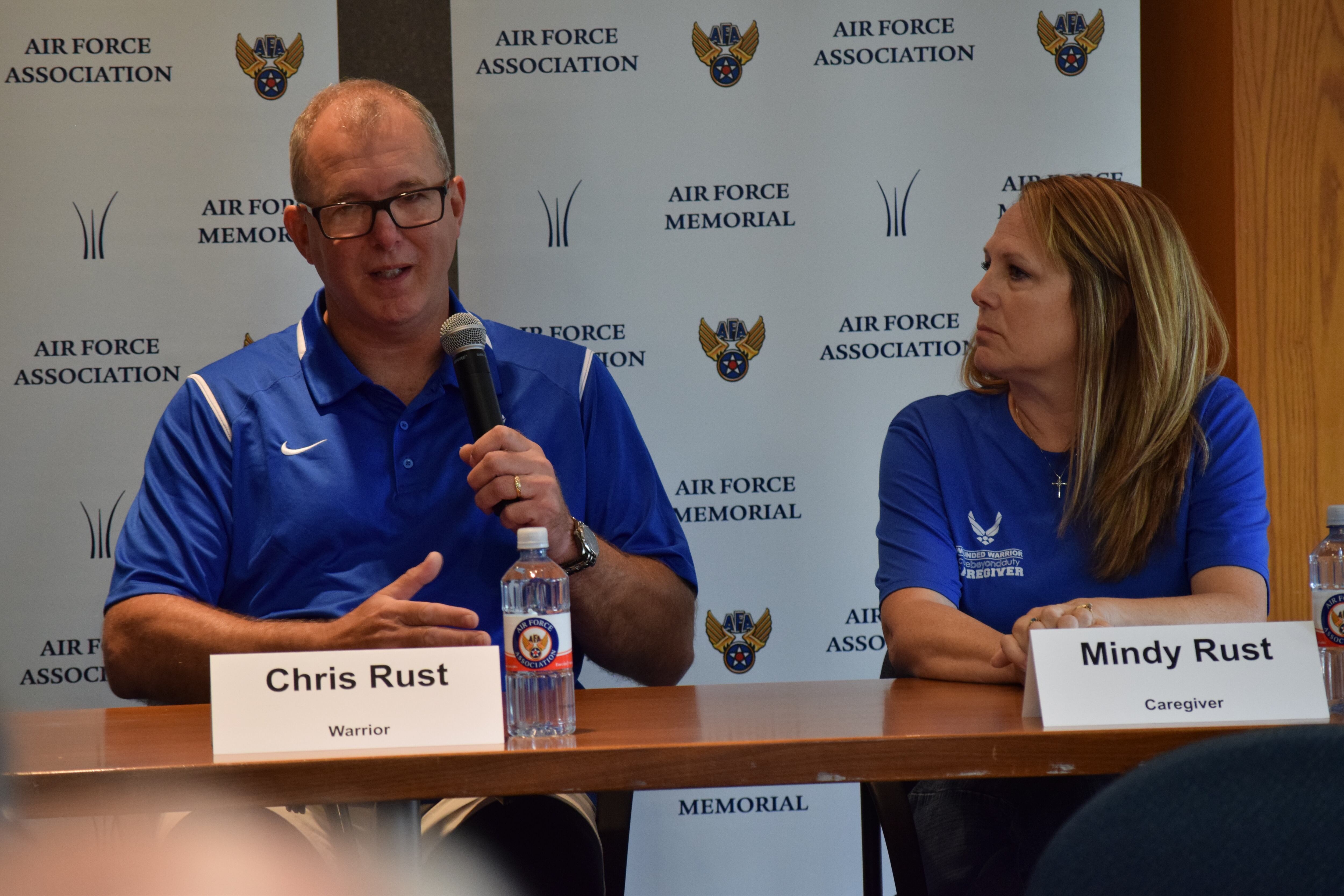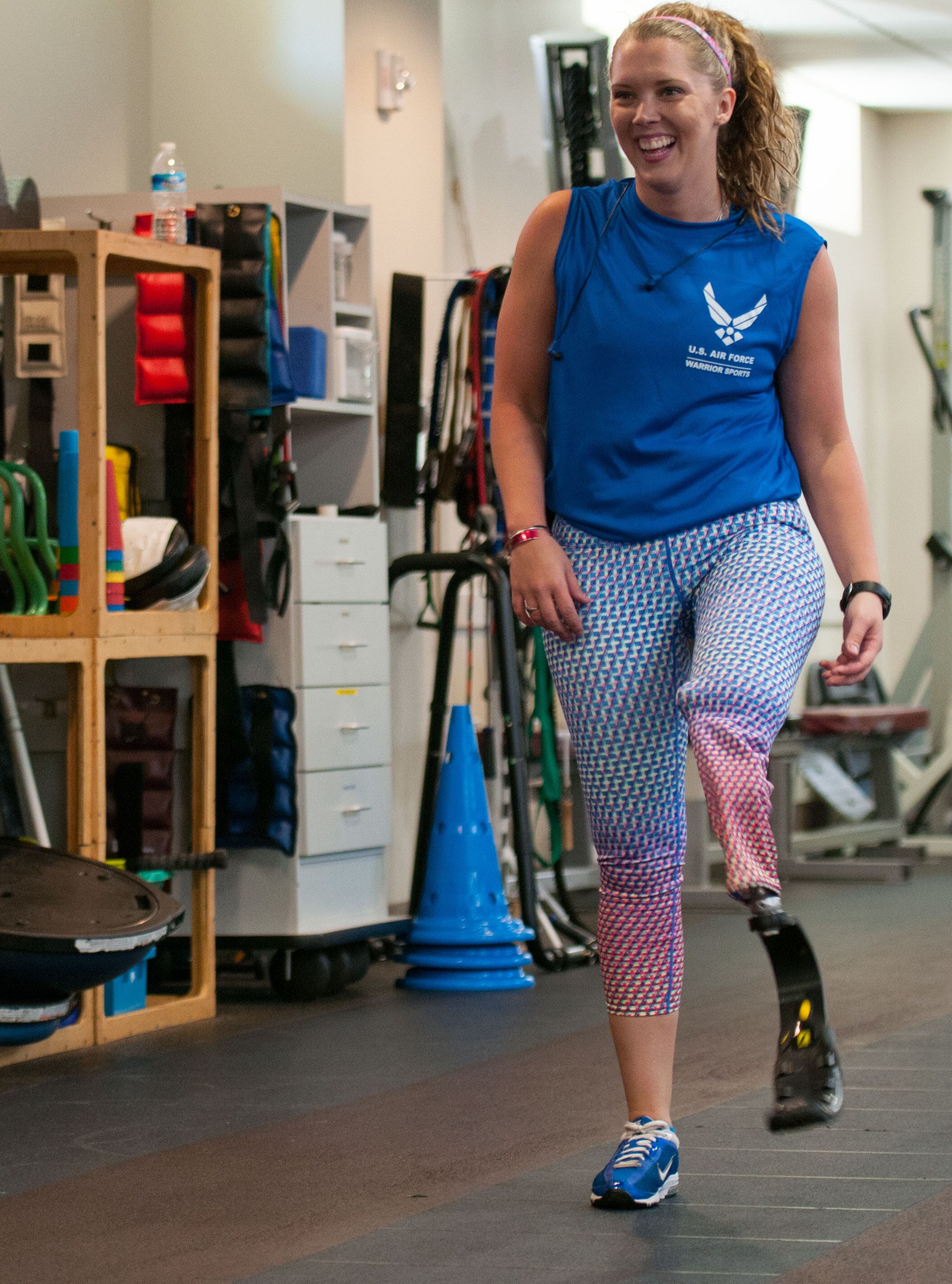Former Staff Sgt. Tino Uli found it hard to put into words what he experienced during his three tours in Iraq.
He didn't have to. The way the brawny ex-security forces airman apologetically paused, blinked back tears, and forced out a simple, "Stuff happened there," told the story of the pain he's been carrying since he first deployed 11 years ago.
But at a June 10 panel at the Air Force Association's headquarters in Arlington, Virginia, Uli and two other airmen told the story of how they were able to bring themselves back from the despair caused by their physical and mental injuries with the help of the Air Force Wounded Warrior Program and its adaptive sports programs.
The program, often referred to by the acronym AFW2, provides personalized care, services and advocacy to seriously wounded, ill or injured airmen — including those who have suffered post-traumatic stress disorder, traumatic brain injury or other medical health conditions — as well as their caregivers and families.
Besides adaptive and rehabilitative sports and caregiver support, AFW2 also provides mentorship to recovering airmen, an employment and career readiness program, and financial assistance for airmen who have suffered or aggravated a catastrophic injury or illness in the line of duty and need help with daily living activities so they can avoid having to be hospitalized or put in a nursing home.
Uli said that when he was medically retired for post-traumatic stress disorder in 2014, he was devastated. He felt like he was expendable, and even became suicidal.
"I didn't know what to do with my life," Uli said. "The past 10 years I served, all I knew was the cops, security forces. I took pride in that. I loved being a cop."
One day, Uli's case manager told him about an Air Force Wounded Warrior adaptive sports camp in Florida and he signed up.
It was amazing, he said. It changed his life.
"AFW2 gives me purpose, it gives me something to work towards," Uli said. "I'm still important. I'm still part of the fight, still part of the team. I'm still part of the Air Force."
And it was at another adaptive sports camp where Uli became a mentor to Technical Sgt. Chris Rust of Russiaville, Indiana, who also sat on the panel. Rust, an aircraft maintainer who has worked on aircraft such as the C-5 and KC-135, had a stroke in November 2013, shortly after returning home from a nine-week deployment to Al Udeid Air Base in Qatar.
Both Uli and Rust said they resisted considering themselves wounded warriors at first — as do many who attend these camps. Uli said he didn't feel like he belonged at the adaptive sports camp because his ailments were not visible in the same way as other wounded warriors there.
Gentle prodding
Rust said it took him about 16 months to even feel comfortable calling himself a wounded warrior. He kept receiving emails inviting him to participate in events, and every time, he hit delete, because he had been immobile for so long he didn't think he was capable.

Chris and Mindy Rust talk about how the Air Force's Wounded Warrior program has helped Chris, who suffered a stroke, and Mindy, his primary caregiver.
Photo Credit: Air Force Association
But one day, he came home to a surprise from his wife and caregiver, Mindy Rust, who also sat on the panel.
"Don't be mad," Mindy told her husband in a soothing tone. "I answered an email for you."
And with that prodding from Mindy, Chris Rust went to his first adaptive sports camp.
Rust was formerly an avid runner, but his stroke caused a clotting disorder in his legs that left him bedridden for a long time. His running days were over, and it crushed him.
"Trying to get him motivated to start moving again was pretty rough," Mindy said.
At his first adaptive sports camp, Rust was struck by what he saw the other veterans there — some amputees, some in wheelchairs — were able to accomplish, and he was finally able to reach out to them.
"You get there, and you realize that they're walking ... and so they're in a wheelchair, we're still communicating as warriors," Rust said. "You realize that we all still have the same dream. The last thing we want to do is be forgotten from the Air Force. This may not work, but this works, and we belong somewhere."
And when Rust first tried a hand cycle at a camp, he once again found the rush he used to get from running.
Mindy also laughed about how Rust at first grumpily dismissed the concept of sitting volleyball: "I'm not sitting on a floor playing volleyball, that's just stupid!" But once he tried it, it became his favorite event. And last year, Rust was on the Air Force's sitting volleyball team that won the joint-service Warrior Care Month Sitting Volleyball Tournament at the Pentagon. Rust also loves archery now.
"Getting him there [to the camp] was the struggle, but once he was there, he was hooked," Mindy said. "I don't have to worry about getting him somewhere else again, because he'll go."
As Rust bonded with other wounded warriors there, they learned what each other needed — and how they could help one another. They keep in touch through Facebook and other forms of social media, he said.
"We challenge each other. What are you doing this week to get better?" Rust said. "Where are you going? What is your plan for your recovery?"
Uli competed in the Invictus Games in Orlando last month in indoor rowing and track and field, and Rust watched online as his friend competed in the events and cheered him on.
Social media also helps wounded warriors trade tips on navigating the medical bureaucracy, Rust said. And the check-in feature on sites like Facebook also helps keep them on track with their recovery, he said. If a wounded warrior's friends notice that veteran hasn't checked in at the gym in a while, they give them a nudge.
That virtual support group provides Rust a level of help his non-wounded colleagues at Grissom Air Reserve Base in Indiana can't provide, though he knows they mean well.
"It seems like I'm the only wounded warrior at Grissom," he said. "They don't get it. 'Hey Sgt. Rust, you look good today!' 'Thank you.' 'Hey, how you doing?' 'I'm good.' And I appreciate that. But when I start talking to my other wounded warrior pals, I can call them immediately and say, 'I'm having a bad day. I need to talk to somebody.' And there are days like that. And you can talk to those other wounded warriors, and they help us through that. It really is a brotherhood."
Uli said the camaraderie he developed with other wounded warriors replaced the bonds he lost when he was retired in 2014 and separated from his fellow airmen. But now, he said, the camaraderie he feels is even greater than when he was on active duty, because each recognizes the challenges the others face.
"I had really bad trust issues," Uli said. "But when I'm [with] my AFW2 warriors, I can trust them. I can let that guard down."
It's not only the wounded warriors who find support networks there. At Rust's first camp, Mindy met other caregivers who had been dealing with the same challenges and strains she had.
"Now, I'm not alone," Mindy said as she wiped away tears. "Now I have a group I can talk to about some of the things we're going through."
Improvements to be made
But while they spoke glowingly of the Wounded Warrior program, they said there are still several things that can improve about how the Air Force treats them. Rust said active duty airmen can get assistance to get the necessary recovery tools, but those resources aren't available to reservists like him. As a result, Rust bought a hand cycle and a bow on his own dime.
And the military needs to do a better job communicating with families of wounded warriors about their status, they said. Rust, for example, has now been going through a medical board for a year and a half. And during lengthy periods of silence from the military, with no updates, his families' fears started to get the better of them.
"When you don't hear anything for months on end, you begin to make stuff up in your head," Mindy said.
Rust also said his transfer from active duty to reserve status after his stroke created more bureaucratic complications to overcome.
"That is a very gray area," Rust said. "Unfortunately when you become a wounded warrior on Title 10, as a reservist, you find that, oh boy — I've got my parent guidance over here from active duty. But wait a second — my reserve command still hasn't put their stamp on this program, on my medical evaluation process. Holy cow, now wait a second — you guys over here need to talk to you guys over here. And we've all heard 'I'll have my people call your people.' Unfortunately sometimes you wonder if they have the right phone number."
The experience of seeing how reservists like him are treated has been very discouraging at times, he said.
"I love my reserves, but sometimes we can't get out of our own way to make the process work," Rust said.
During a break, Air Force personnel chief Lt. Gen. Gina Grosso, who gave opening remarks at the panel, spoke to Rust about the problems he faced.

Heather Carter, a medically retired senior airman, walks on a track inside the Military Advanced Training Center at Walter Reed National Military Medical Center in Bethesda, Md., April 13. Carter and other amputees receive physical and occupational therapy at the center as they work toward their goals. Carter wants to return to competitive softball.
Photo Credit: Sean Kimmons/Air Force
Still struggling
They still struggle. Rust said he suffers from memory issues, mild depression and outbursts of anger.
"Our running joke is, we have a Rubbermaid trash can that has seen every wall in my garage, and it's still there," Rust said.
Uli now lives in Crawley, Texas, and is planning to pursue a degree in sports medicine. For him, the best medicine is to keep busy keeping up with his doctor's appointments, going to the gym, cycling and walking his dogs.
"I walk my dogs a lot," Uli said. "When I have an anger outburst, my girlfriend tells me, 'You better go walk the dogs.' If I don't keep myself busy, then my mind's getting blown."
Former Senior Airman Heather Carter, who served in the Air Force for four years as a signals intelligence analyst, shattered her leg in 2010 playing softball with her fellow airmen. About four and a half years later, Carter had to have her leg amputated.
But today, Carter has returned to the softball field, and practices daily for the Wounded Warrior softball team.
"Someone who may be missing limbs — they're disabled, but they're not broken," Carter said. "We're still able and capable to do everything we want to do. It just may take us a little longer."
Stephen Losey is the air warfare reporter for Defense News. He previously covered leadership and personnel issues at Air Force Times, and the Pentagon, special operations and air warfare at Military.com. He has traveled to the Middle East to cover U.S. Air Force operations.





